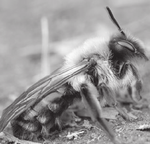Abstract
1. Animal life span is constrained by ecology and physiology. The latter has been studied under controlled conditions, but little is known about determinants of life span under natural conditions.
2. We studied the relationships between length of adult life, magnitude of foraging activity, and environmental abiotic conditions in two bee species: a pollen specialist Andrena vaga (Andrenidae) and a pollen generalist Anthophora plumipes (Apidae).
3. Our research indicates that life span is driven both directly by climate and indirectly through climate-dependent activity patterns. We found a negative relationship between proportion of active days and length of life; in contrast, a high activity rate within the active days had no negative effect on longevity.
4. Individuals active during warm and/or wet days lived longer, with precipitation being a more important determinant of life span than temperature.
5. Timing of the first appearance at the site was also an important predictor of bee life span. Individuals that first appeared closer to the end of season (critical time horizon) lived a shorter time than individuals observed earlier. The first observed active day in the season was also correlated with seasonal temperature and precipitation.
6. We demonstrate that life span and activity patterns of wild populations of insects are regulated by a tractable interplay of ecological (mostly climatic) variables that were previously studied only in isolation or in vitro.
